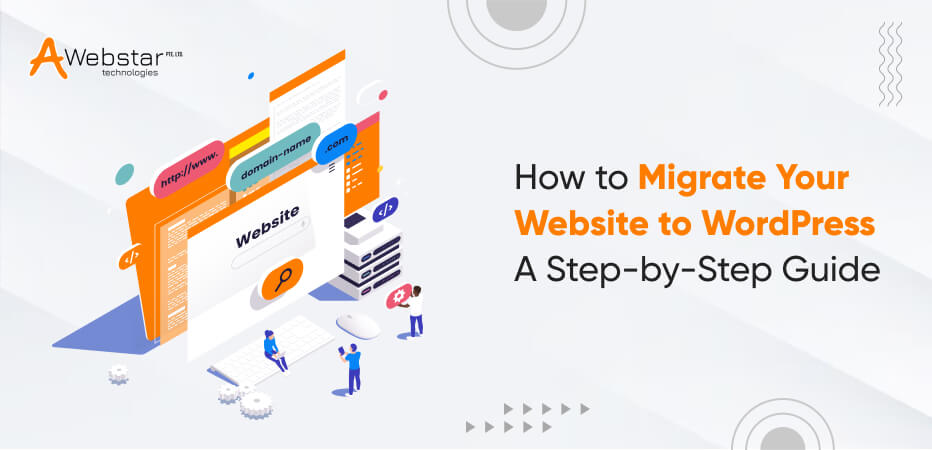
Growing and establishing your online presence is essential in this era of digitisation. Migrating your website to WordPress is a key step towards achieving your online objectives. With our WordPress development services, you can enjoy better performance, enhanced security, and explore new possibilities. This migration process should not affect the appearance, content, or functionality of your existing website. Although WordPress migration can be a challenging process, our expert services ensure that your site’s data is preserved and functionality remains intact.
This blog post will guide you through WordPress Website migration. It will explain the process of smoothly transferring your website from one hosting environment to another. This guide will explore details for migrating for the first time or just refining your existing process. So, let us dive in!!
Benefits of Migrating to WordPress
There are many benefits of migrating your existing website to WordPress. Let us discuss them one by one below now.
Easier to Manage and Use
WordPress displays a user-friendly interface that allows users to update content, add new pages, and customise layouts effortlessly. Its simple interface simplifies tasks to a great extent. Also, it includes content editing, image uploading and plugin management.
A Whole Library of Plugins at Your Disposal
WordPress provides a vast library of themes and plugins. This enables you to enhance functionality and design without extensive coding knowledge. The abundance of plugins makes it easy to tailor your site to meet your specific goals. It helps to create a truly customised online presence.
They empower you to extend the capabilities of your website. This enhances user experience and simplifies management tasks. You achieve all this without the requirement of extensive coding or development expertise.
Improved Search Engine Optimization (SEO)
WordPress has built-in Search Engine Optimization (SEO) features and plugins like Yeast SEO. These help you attract more organic traffic and increase your site’s online presence effectively. You will gain control over meta tags, sitemaps and content optimisation. It leads to visibility and search engine rankings.
Steps to Migrate Your Website to WordPress
Migrating a WordPress site from one host to another is quite stressful.
You will need help to get started if you are not afraid to roll up your sleeves and migrate your site by yourself. Let us walk you through the entire process, one step at a time.
Backup Your WordPress Website
The first step to migrate WordPress site is to back up all your site data. It is regardless of how small or large it is. Backing up your site is a critical component of the data transfer process. There are several plugins you can use to back up your website. These include Duplicator or UpdraftPlus.
They permit you to utilise built-in settings to control backed-up files, backup schedules, and where your data is stored. Hence, regularly backing up your WordPress website is essential for safeguarding your data. It also minimises the risk of data loss during the migration process.
Choosing the Right Hosting Provider
The selection of the right hosting provider is important. It ensures the performance, security and reliability of your WordPress website. The main considerations include server uptime and customer support quality to find a provider. Apart from these, scalability options and server location to find a provider must be considered.
Upload backup files to the new database
Firstly, access your new server through an FTP client like FileZilla. Then transfer all files from your existing WordPress setup to the designated directory on the new server. It is important to ensure consistency by preserving the identical file structure and directory paths.
Move WordPress Website to New Host
The migration of your WordPress website involves transferring all website files and databases to a new hosting server. It ensures a smooth transition without the loss of any data or functionality. Proper planning and execution are highly required. This will maintain integrity throughout the whole migration process.
Installing WordPress on the New Host
It is quite simple to install WordPress on the new host. Access the hosting control panel and locate the “WordPress” installer. Then, follow the prompts to set up WordPress. This includes choosing a domain and directory. Also, it involves creating an admin account and completing the installation.
Export the WordPress database
Most hosts allow you to access and export the WordPress database through a management panel like PHPMyAdmin. You can also use custom options to make it faster to download.
This file contains all your posts, pages, comments and settings. They are neatly organised for safekeeping or migration. It is important to perform regular backups to safeguard against any unexpected mishaps.
Migrating files using FTP
Using a plugin for many migrations is fine. However, for more complex migrations you may need to manually migrate your website. This is done by using an FTP connection. You should consult with your hosting provider for the correct configuration of this connection. Also, you typically need the username and password of your hosting account. The FTP address and the correct port number must be known beforehand.
Post-Migration Strategies
At this point, you have done all the work of migrating your website to WordPress site. This is the last step to perform to complete your migration process. It is important to ensure optimal performance and maintain SEO integrity. You must begin by updating your essential SEO tools. It will ensure compatibility with the new hosting environment and any changes made during the migration. Also, perform an SEO backup to safeguard your SEO settings, meta-data and other optimisation configurations.
SEO Considerations
It is important to ensure proper redirects. These must be set up from old URLs to their corresponding new URLs. This would maintain search engine rankings and user experience.
Furthermore, update your website’s sitemap to reflect any changes in the URL structure. This helps search engines crawl and index your site efficiently. It helps improve the overall SEO performance of the website.
Testing and Going Live
Once your migration process is complete it is time to thoroughly test your website on the new server. You must check all your pages, posts, media files and functionality. This is to ensure everything is working properly. Also, pay attention to forms, contact pages and interactive elements.
Conclusion
Migration of your existing website to WordPress greatly influences your online presence. Also, with the assistance of a reputable WordPress website development company can provide a smooth transition. Their expertise ensures a high-quality site.
Awebstar Technologies provides professional guidance and customisation services aligned with your unique needs. Our experienced team provides WordPress development services at a minimal cost while maintaining overall quality.















































